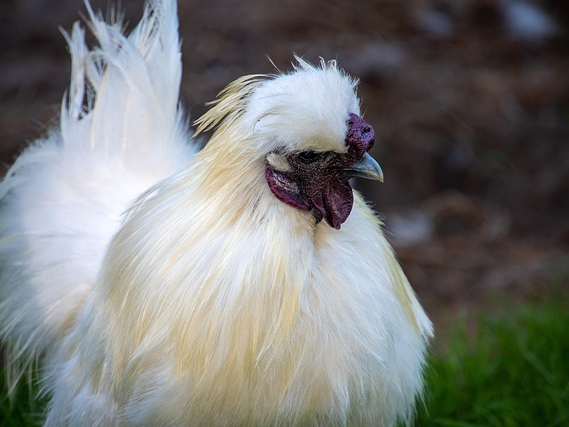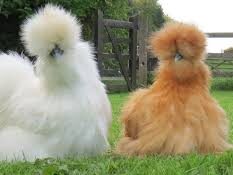Silkie Bantams are the pom-poms of the chicken world – fluffy, friendly, and packed with personality. They’re a bantam breed (small chickens) that trace back to ancient Asia. Early accounts pop up in Chinese and Japanese records, and even Marco Polo wrote of a “furry” black chicken in the 13th century. By the 1500s they reached Europe, and the American Poultry Association officially recognized Silkies in 1874. These birds have since been bred for shows and pets rather than mass egg production. Today’s Silkies are beloved backyard stars.
Physical Appearance and Unique Features
Silkies are instantly recognizable by their fluffy plumage – more like soft fur or cotton candy than typical feathers. Their feather barbs lack the hooks (barbicels) that hold normal feathers together, so Silkie feathers fall in tufts and don’t lie flat. This gives them a “silky” or fuzzy look (hence the name) but also means they can’t fly well. Silkies come in many colors: common show varieties include white, black, blue, buff and partridge (plus splash, gold, etc.) recognized by poultry clubs. They often have feathered legs (“muffs” and “boots”), a crest (puffed topknot), and some have a fluffy beard around the face.


Beyond the fluff, Silkies have striking skin and bones. Their skin is a dark bluish-black, and their bones (and even internal organs) are pigmented, due to a genetic trait called fibromelanosis. They also sport 5 toes on each foot (almost all chickens have four). Other neat quirks: Silkies have blue earlobes and small “walnut” or cushion combs. They’re bantams in the US (tiny bodies: roosters ~3–4 lbs, hens ~2–3 lbs) but are considered full-size in the UK. In short, expect a chicken that looks like it got dressed up in grandma’s boa, complete with a pompom hat.
Egg Production and Laying Behavior
Silkies lay small cream-colored eggs, typically a few inches big (smaller than a standard hen’s egg). A healthy Silkie hen usually starts laying at about 7–9 months old, which is slower than many breeds. Once mature, you can count on roughly 2–3 eggs per week, or about 100–120 eggs per year if she doesn’t go broody. Don’t expect a Silkie to lay a basketful – they’re classified as poor layers compared to production breeds. Their tendency to snooze on the nest means long breaks between clutches.
One fun Silkie egg fact: their yolks can be extra-rich and golden. And yes, Silkie eggs are perfectly edible – they taste like other chicken eggs, just smaller. Hens may lay year-round in warm climates (with sufficient daylight), but in cold or dull months they’ll slow way down and often just curl up to brood instead.
Temperament and Behavior with People and Other Chickens
Silkies are known for their calm, goofy dispositions. They are gentle, docile, and friendly – the couch potatoes of the coop. Roosters even have a cute, quiet “call” instead of a full-throated crow. These birds adore attention and can imprint on humans, happily following you around the yard or even enjoying a lap like feathered puppies. Kids especially love Silkies; their size and soft feel make them great “starter” chickens. They tolerate handling well and generally won’t peck or nip.
With other chickens, Silkies are usually on the bottom of the pecking order. They’re too easygoing to be bossy. In a mixed flock they can get bullied by more aggressive breeds, so it’s wise to keep Silkies with other docile birds or just each other. Their vision can also be partly blocked by their fluffy crests, so shy Silkies might not see a hawk until it’s almost too late. Overall, though, these are some of the friendliest chickens you can raise. They make superb pets, as homey companions – many owners report Silkies following them around or chirping softly just to say hello.
Climate Tolerance – Heat and Cold
Silkies prefer fair weather. Their unusual plumage doesn’t trap heat or repel water well. In the rain or damp cold their fluff soaks up moisture instead of shedding it, leaving them bedraggled. In freezing weather, wet feathers can freeze solid on a Silkie and cause frostbite (especially on combs and feet). Silkies’ foot feathers can clump with snow or mud, too. In short, they are not very rainproof or iceproof. To keep Silkies comfortable, provide a dry, draft-free coop (consider winter insulation) and keep their head feathers trimmed so they don’t walk into snowdrifts blind. In cold snaps, you can give them a safe heat lamp – their downy feathers aren’t as warm as they look.
In hot weather, Silkies do okay but also need caution. Their fluff can make them prone to overheating; good ventilation, shade, and plenty of cool water are a must. Overall, Silkies do best in mild climates. With a solid coop and protection from the worst weather, they can do fine almost anywhere – but this breed definitely appreciates help staying dry in winter and cool in summer.
Pros and Cons of Owning Silkie Bantams
Pros: Silkies are adorable and extremely friendly – it’s hard not to smile when you see their pompom crests bobbing around. They’re very docile and kid-friendly (even Roos are usually gentle). Their small size and fluffy “stuffed animal” look endears them to people of all ages. They’re also famous brooders: Silkie hens have a powerful instinct to sit on eggs and will hatch just about any clutch put under them (even duck or quail eggs). For anyone wanting a surrogate hen, Silkies are perfect incubators. They’re quiet too (no loud alarm crows) and surprisingly easy to contain since they flutter more than fly.
Cons: On the flip side, Silkies are awfully light on eggs – not ideal if you need lots of daily eggs. They’re also frail against predators. Silkies’ limited vision and inability to fly well mean they can be easy targets; always use secure, covered runs and keep an eye out for raccoons, dogs, hawks, etc. Their feathered face can need occasional trimming so they can see. It’s also a pain that you usually buy straight-run chicks (mixed sexes) because Silkies are hard to sex – you might unknowingly end up with a rooster in your chicks. And of course, they have the climate sensitivity mentioned above: wet, muddy, or extreme conditions can challenge them. Finally, their gorgeous plumage needs a bit more grooming – watch for mites hiding in the fluff, and be gentle when handling (they bruise easier than standard-feathered birds).
Where to Buy Silkie Bantams in the U.S.
Looking to add Silkies to your backyard? Several reputable hatcheries and breeders across the U.S. offer Silkies (usually as chicks or pullets). Top hatcheries include Murray McMurray Hatchery, My Pet Chicken, Cackle Hatchery, Ideal Poultry, Hoover’s Hatchery, Stromberg’s, and Hillcrest, among others. Many of these sell Silkies seasonally (often spring and early summer) either as chicks or fertilized eggs. Specialty breeders like ChickensForBackyards, Valley Hatchery, and Freedom Ranger Hatcheries also offer silkie bantams by mail. Before buying, check reviews and ask if they vaccinate (Silkies are prone to Marek’s disease, so vaccinated stock is a plus).
Once you’ve got your Silkies lined up, don’t forget the supplies! They do fine in the same kind of small coop and feed as other bantams. For example, a compact wooden coop with an attached run is ideal for 3–4 Silkies. Make sure the run is predator-proof. Feeders and waterers should be low or have ramps, since Silkies can’t jump very high. Standard chicken feeders and watering systems work well. It’s wise to have layer feed supplemented with oyster shell or crushed eggshell for calcium. A probiotic or poultry vitamins (available at farm supply stores) can keep Silkies in good health.
Frequently Asked Questions
1. Are Silkie chickens good pets? Absolutely. Silkies are renowned for being calm, gentle, and affectionate. They tolerate handling and often enjoy being around people. Because of their cute looks and sweet nature, many keepers describe them like living toys or therapy animals. Kids and first-time chicken owners often start with Silkies. Just remember they’re also chickens – so they still need space to scratch and dust-bathe – but yes, they make delightful backyard pets.
2. How many eggs will my Silkie lay? Expect one every few days on average. A typical Silkie hen lays about 2–3 small eggs per week, roughly 100–120 eggs per year under good conditions. That’s much lower than the 250+ eggs a commercial layer might give. Also, when Silkies decide to sit on a nest, they often stop laying completely for that period. In short: Silkies lay intermittently, so plan on collecting a couple eggs a week rather than daily farm-fresh omelets.
3. Do Silkies really have black meat and bones? Yes! It sounds like a myth, but it’s true. Silkies carry a genetic trait that causes dark blue-black pigmentation in their skin, muscles and bones. If you’ve ever seen the Asian delicacy “black chicken soup,” those are usually Silkies. It doesn’t change the taste of the meat much (it tastes like any chicken), but it does look spooky if you cut one open. On the coop menu, though, we stick to layer feed – most Silkies are pets rather than dinner.
4. Why does my Silkie keep going broody? Silkie hens have an exceptionally strong maternal instinct. They will literally sit on anything that resembles an egg – a golf ball, a bean bag, or anything else. This is a breed characteristic. If you want eggs, you may have to gently break her broodiness or give her fake eggs in the nest only when you want her to sit. But if you’re into hatching chicks, this is a pro: Silkie moms are awesome at sitting on and raising offspring. Their fluff even helps keep chicks warm (though their very long down can sometimes tangle little chicks, so some breeders cross Silkies to avoid overly dense fluff on the hen).
5. Are Silkies cold-hardy? Not really – at least not compared to tighter-feathered breeds. Their airy “hair” doesn’t insulate like smooth feathers. Silkies are less tolerant of wet or extreme cold. In freezing, wet, or snowy weather they can get chilled easily. It’s important to keep them dry (a good roof and bedding in the coop) and draft-free. In winter you might provide a safe heat source if nights get very cold. On the bright side, Silkies do fluff up dramatically to trap heat, and they’ll often roost with heavier breeds for warmth. Still, plan to baby them a bit: keep them out of puddles, change wet bedding, and trim really long foot feathers so snow doesn’t pack. In short: Silkies can survive winter, but they need a bit more coop TLC in cold, wet climates.
Silkies may require special care in some ways, but their charming looks and lovable characters make the extra effort well worth it!
